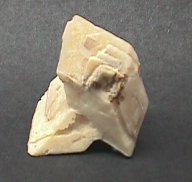The Mineral glauberite

Many Glauberite specimens in collections are not truly Glauberite, but rather other minerals that formed a pseudomorph or epimorph over the Glauberite. Glauberite itself is in fact a rare and unstable mineral, but its remnants and castings are much more prevalent. This is evident by an abundance of empty casts and pseudomorphs found in localities where little or no Glauberite was ever found. There are some localities where hollow Glauberite crystal casts can be found in a rock or mineral base with the original Glauberite completely dissolved.
Glauberite forms in evaporite and clay deposits. These environments enable a crystal to grow without interference from attached matter, so crystals can be perfect on all sides. Such crystals are known as floater crystals.
Some Glauberite pseudomorphs from Camp Verde, Arizona, exhibit a deep green color. These are not natural and have been artificially dyed by certain dealers, thus the buyer should be aware.
True Glauberite does not keep well in collections for it is efflorescent, developing white powder on its surface which dulls its luster. To avoid this, specimens should be placed in conditions where this effect is minimal, such as a damp area. Pseudomorphs and epimorphs are stable and don't require extra protection from humidity.
Glauberite is named after the Dutch/German chemist Johann Rudolf Glauber (1604-1668), who discovered sodium sulfate in 1625.
Glauber's salt, a powder of sodium sulfate is also named after Glauber.
Chemical Formula
Na2Ca(SO4)2
Color
Colorless, beige, yellow, gray, light brown
Crystal System
Monoclinic
Properties
Streak
White |
Hardness
2.5 - 3 |
Transparency
Transparent to translucent |
Specific Gravity
2.7 - 2.8 |
Luster
Greasy, vitreous, or dull |
Cleavage
1,1 - basal |
Fracture
Conchoidal |
Tenacity
Brittle |
Other ID Marks
1) Has a mild taste like salt.
2) Slowly dissolves in water. |
Crystal Habits
In characteristic steep bipyramidal crystals that are often well-formed. Crystals are sometimes striated, they may have rounded edges, and they occasionally dissolve internally, leaving hollow crystal shells. Also encrusting and in compact crystal aggregates.
Uses
Glauberite is used for the extraction of Glauber's salt.
Noteworthy Localities
Glauberite is found in Europe in Salzburg, Austria; Strassfurt, Germany; and in the Consuelo Mine, Chinchon, Spain. It also comes from Bumbunga Lake, Lochiel, South Australia; and several localities in the Atacama Desert of Chile.
In the U.S., Glauberite comes from several dry lake deposits and arid regions in Southern
California, such as Searles Lake, San Bernardino Co.; the Bertram Mine, Imperial County; and the Saline
Valley, Inyo Co.
One of the most well-known localities of Glauberite is Camp Verde, Yavapai Co., Arizona, where large Glauberite crystals have been pseudomorphed to Calcite and Gypsum.
Empty Glauberite casts, most with Quartz overgrowths, have been found in several of the traprock quarries in Northern New Jersey, specifically Paterson, Prospect Park, and Montclair University in Little Falls, all in Passaic Co. New Jersey. Outstanding Prehnite pseudomorphs after Glauberite have come from Fanwood, Union Co., New Jersey.
Common Mineral Associations
Halite, Anhydrite, Thenardite
Distingushing Similar Minerals
Glauberite's crystal form and occurrences distinguish it from all minerals.